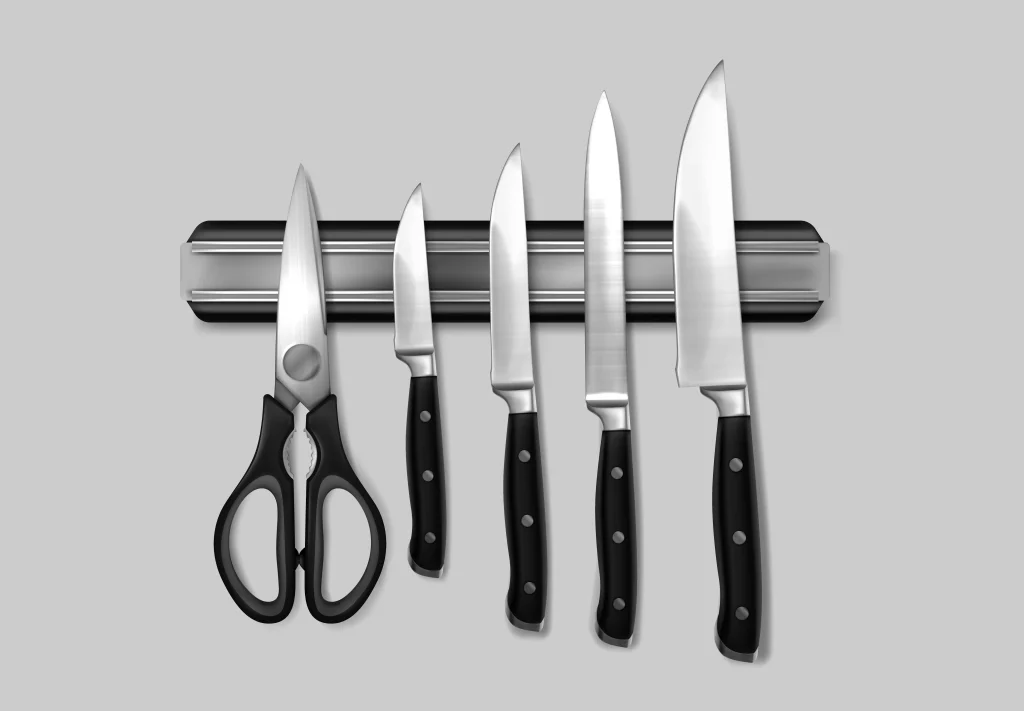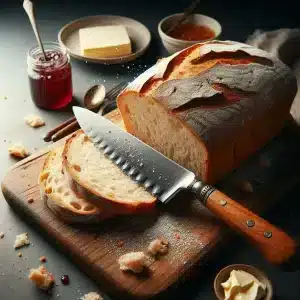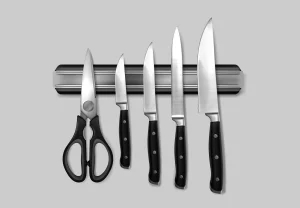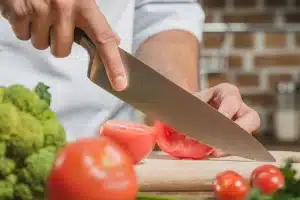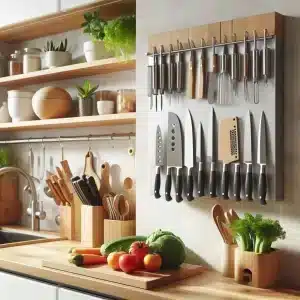Properly storing kitchen knives is essential to maintaining their sharpness, ensuring safety, and extending their lifespan. Poor storage can dull knives quickly or, worse, create a safety hazard in your kitchen. With numerous storage options available, from knife blocks and magnetic strips to drawer organizers and knife covers, understanding the differences will help you choose the right method for your needs. In this article, we’ll explore the best ways to store your kitchen knives and how to keep them in excellent condition.
Common Knife Storage Options
- Knife Blocks: Tradition and Functionality
Knife blocks have been a classic storage option for decades and remain one of the most common ways to store knives. Their popularity is due to the combination of simplicity, functionality, and design. Blocks keep knives organized and easily accessible on the countertop. With individual slots for each knife, this method prevents the blades from touching each other, protecting their sharpness and extending their durability.
However, not all knife blocks are the same. Some come with predetermined slots that might not fit the size or type of knife you own, which can be inconvenient if you have a varied collection or non-standard-sized knives. Traditional blocks can also retain moisture if knives are not dried thoroughly before storage, potentially damaging the blades over time and promoting rust in certain steel types.
Despite these potential drawbacks, knife blocks remain an excellent choice if you like to have your knives always within reach. They’re particularly useful for cooks who use their knives frequently and want to keep them ready for action. To ensure longevity, it’s important to keep the block clean and dry, and to check it regularly to prevent dust or residue from building up inside the slots.
- Magnetic Knife Strips: Modern and Minimalist Solution
Magnetic strips have become a popular choice for those who want to save space and add a modern touch to their kitchen. These strips are mounted on the wall, allowing you to display your knives in an orderly and visually appealing manner. One of the main advantages of magnetic strips is that the blades don’t touch each other, which helps preserve their sharpness.
In addition to their sleek look, magnetic strips are highly practical. They provide excellent visibility for all your knives, making it easier to quickly grab the right one while cooking. However, it’s crucial to ensure that the strip is installed securely and that it’s strong enough to hold heavy knives. Low-quality strips might have weak magnets, increasing the risk of knives falling, which could not only damage them but also cause accidents.
Another important consideration is keeping the magnetic strip clean. Make sure both the knives and the strip are free of debris and moisture, as these could affect the magnetism or cause the blades to rust. When installed properly, a magnetic strip can be a highly functional option, especially in small kitchens or for those who prefer to keep their knives in plain sight.
- Drawer Organizers: Safety and Discretion
If you prefer to keep your knives out of sight while ensuring their protection, drawer organizers are an ideal solution. These organizers are designed to hold knives of various sizes in individual compartments, preventing them from moving or clashing together. This not only protects the blades but also adds a level of safety by keeping the knives stored securely in a designated space.
One of the standout advantages of drawer organizers is their ability to keep the kitchen looking tidy, as the knives are kept out of sight. Many organizers are adjustable, allowing you to store different types and sizes of knives, making them highly versatile. However, it’s essential to make sure that knives are completely dry before placing them in a drawer, as accumulated moisture can damage both the blades and the organizer.
Drawer organizers are especially useful for people who value order and safety in the kitchen. They’re also a great option if you have a large, diverse knife collection, as you can customize the space inside the drawer for each type of knife. Plus, by keeping the knives safely organized, you reduce the risk of accidents when reaching for other utensils in the same drawer.
- Knife Cases: Protection for Chefs on the Move
Knife cases are primarily designed for professional chefs or for those who need to transport their knives regularly. These cases, usually made from durable fabric or leather, offer individual compartments for each knife, ensuring that the blades do not get damaged or dulled during transport. Some cases also include space for other utensils, such as scissors or sharpening tools.
One of the major benefits of knife cases is that they protect knives effectively, not only during transport but also when they are not in use. This is especially useful if you have high-quality knives or prefer not to leave them out on the countertop or in a drawer. However, using cases might not be the most practical option for everyday use at home, as it can be cumbersome to take the knives out and put them back each time you need them.
If you choose a knife case, make sure it’s made from high-quality materials and is easy to clean. Also, check that the zippers or closures work properly to avoid accidents or knives slipping out of place. Knife cases are an excellent option for those who value portability and want to keep their knives protected when not in use.
- Knife Covers: Simple and Accessible Protection
Knife covers are a straightforward and budget-friendly solution for protecting your knives, especially if you don’t have a dedicated space for them in the kitchen. These covers fit over the knife blade, preventing it from dulling or getting damaged when stored in a drawer or during transport. They’re very useful for people who prefer to keep their knives in enclosed spaces and out of sight.
One advantage of covers is that they provide basic protection without taking up much space or requiring special installation. They’re perfect if you have a small kitchen or prefer to store your knives alongside other utensils in the same drawer. However, covers might not be as convenient if you use your knives frequently, as placing them on and taking them off each time can be a bit of a hassle.
Make sure to select covers that are of good quality and fit your knives properly. It’s also recommended to keep them clean and dry to prevent moisture from accumulating inside the cover, which could damage the steel over time. Knife covers are a practical and accessible option for those looking for basic knife protection without added complications.
Best Practices for Storing Knives
Tips to Keep Knives Sharp While Storing
- A sharp knife not only makes cooking easier but also safer. To keep knives sharp while in storage, it’s crucial to avoid letting the blades come into contact with hard surfaces. Drawer organizers, magnetic strips, and well-designed knife blocks can help keep your knives sharp and in perfect condition.
- Additionally, sharpening knives regularly before storing them can help extend their lifespan and ensure they’re always ready for use. Using a high-quality knife sharpener or honing steel after each use will help prevent the blades from dulling quickly.
- Lastly, make sure not to store knives with food residue or without drying them completely. Prolonged exposure to moisture or grease can affect both the sharpness and integrity of the steel, especially for non-stainless steel knives.
Common Mistakes to Avoid When Storing Knives
- Storing knives incorrectly can shorten their lifespan or, worse, lead to accidents. One of the most common mistakes is keeping knives loose in a drawer without protection. When knives bump into each other or other utensils, they can become dull and even sustain severe damage. Additionally, this method increases the risk of cuts when rummaging through the drawer.
- Another frequent mistake is not drying knives properly before storing them. Prolonged moisture exposure can lead to rust, particularly in carbon steel knives. Always make sure to clean and thoroughly dry the blades before placing them in any storage system.
- Finally, neglecting to sharpen knives before storing them is a mistake many people make. Even with the best storage system, a dull knife becomes less effective over time. Regular maintenance, combined with proper storage, is key to extending a knife’s lifespan.
Choosing the Right Storage System for Your Kitchen
Not all kitchens are the same, and therefore, not all kitchens need the same knife storage system. When choosing the right method, the first thing to consider is the available space. If you have a small kitchen, a magnetic strip or drawer organizer might be the best option since both save countertop space.
Lifestyle also plays an important role. If you cook frequently and use a variety of knives, a knife block or magnetic strip will allow you to have them within reach and ready to use. On the other hand, if you only cook occasionally, a knife case or cover may be sufficient to keep them safe and protected.
Finally, consider the number of knives you have. If you have a large collection, you’ll need a bigger and more customized storage system, such as a block with multiple slots or an adjustable drawer organizer. If you only own a few essential knives, a more compact system will do.
Special Considerations for Different Types of Knives
Best Storage Methods for Stainless Steel Knives
Stainless steel knives are popular for their resistance to rust, but that doesn’t mean they don’t need care when stored. The key to keeping these knives in good shape is avoiding moisture buildup. Although stainless steel is more corrosion-resistant, it can still be damaged if stored with food residue or not fully dried.
For these types of knives, magnetic strips are an excellent option, as they allow the blades to “breathe” and stay dry. It’s also recommended to avoid wooden blocks with closed slots, as moisture could get trapped inside, affecting the blade over time.
Of course, it’s important to keep stainless steel knives sharp as well. Although they don’t rust as easily as carbon steel knives, frequent use can still dull the blade if not stored properly.
Storing Knives Safely in Homes with Children
Safety is a top priority in any household, especially with small children around. In this case, it’s essential to choose a storage method that keeps knives out of children’s reach, while still allowing adults to access them easily.
Drawer organizers with secure compartments are an ideal option, as they allow you to store knives discreetly and safely. Another option is using knife cases or covers and storing them in a high, out-of-reach location.
If you prefer a visible method like a magnetic strip, be sure to install it high enough so that children cannot reach it. Whatever system you choose, it’s important to ensure that knives are always stored safely and orderly.
Additional Care: How to Clean Knives Before Storing?
An essential step in proper knife storage is cleaning them thoroughly before putting them away. Leaving food residue, grease, or moisture on the blades can damage them, even those made of stainless steel. Always hand-wash your knives with warm water and mild detergent immediately after use.
Avoid washing knives in the dishwasher, as the high heat and clashing with other utensils can damage both the blade and the handle. Once cleaned, dry them well with a soft cloth before storing them in your chosen storage solution.
For high-end knives, it’s recommended to apply a bit of mineral oil to the blade after cleaning, which will help prevent rust and keep the edge in good condition. This extra care ensures that your knives last longer, even with regular use.

